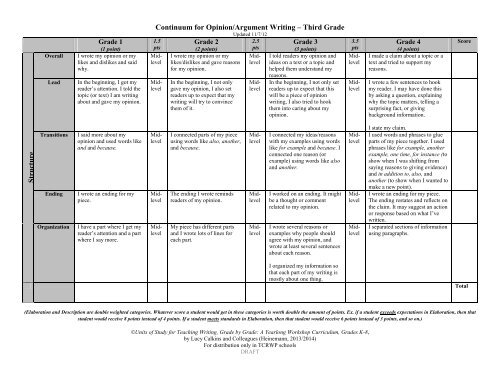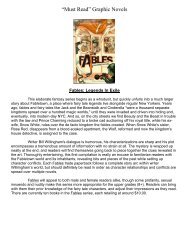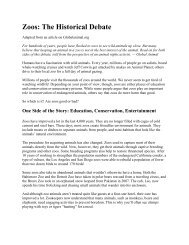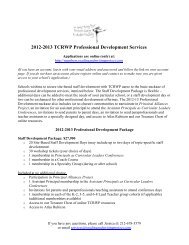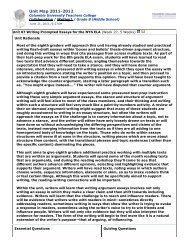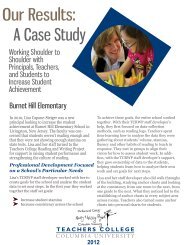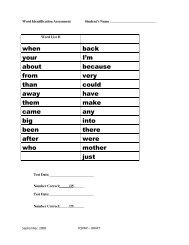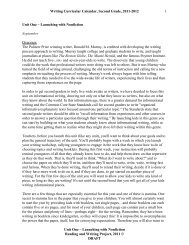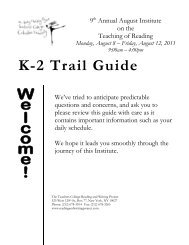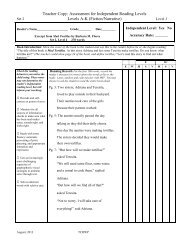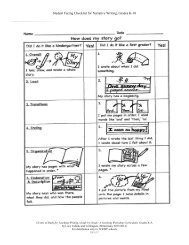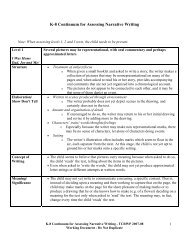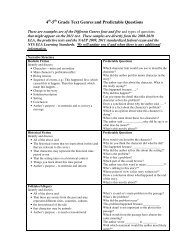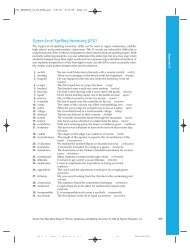Continuum for Opinion/Argument Writing â Third Grade S tru cture
Continuum for Opinion/Argument Writing â Third Grade S tru cture
Continuum for Opinion/Argument Writing â Third Grade S tru cture
- No tags were found...
You also want an ePaper? Increase the reach of your titles
YUMPU automatically turns print PDFs into web optimized ePapers that Google loves.
OverallLead<strong>Grade</strong> 1(1 point)I wrote my opinion or mylikes and dislikes and saidwhy.In the beginning, I got myreader’s attention. I told thetopic (or text) I am writingabout and gave my opinion.<strong>Continuum</strong> <strong>for</strong> <strong>Opinion</strong>/<strong>Argument</strong> <strong>Writing</strong> – <strong>Third</strong> <strong>Grade</strong><strong>Grade</strong> 2(2 points)I wrote my opinion or mylikes/dislikes and gave reasons<strong>for</strong> my opinion.In the beginning, I not onlygave my opinion, I also setreaders up to expect that mywriting will try to convincethem of it.Updated 11/7/122.5pts<strong>Grade</strong> 3(3 points)I told readers my opinion andideas on a text or a topic andhelped them understand myreasons.In the beginning, I not only setreaders up to expect that thiswill be a piece of opinionwriting, I also tried to hookthem into caring about myopinion.1.5ptsMidlevelMidlevel3.5ptsMidlevelMidlevelMidlevelMidlevel<strong>Grade</strong> 4(4 points)I made a claim about a topic or atext and tried to support myreasons.I wrote a few sentences to hookmy reader. I may have done thisby asking a question, explainingwhy the topic matters, telling asurprising fact, or givingbackground in<strong>for</strong>mation.ScoreS<strong>tru</strong><strong>cture</strong>TransitionsEndingOrganizationI said more about myopinion and used words likeand and because.I wrote an ending <strong>for</strong> mypiece.I have a part where I get myreader’s attention and a partwhere I say more.I connected parts of my pieceusing words like also, another,and because.The ending I wrote remindsreaders of my opinion.My piece has different partsand I wrote lots of lines <strong>for</strong>each part.I connected my ideas/reasonswith my examples using wordslike <strong>for</strong> example and because. Iconnected one reason (orexample) using words like alsoand another.I worked on an ending. It mightbe a thought or commentrelated to my opinion.I wrote several reasons orexamples why people shouldagree with my opinion, andwrote at least several sentencesabout each reason.MidlevelMidlevelMidlevelMidlevelMidlevelMidlevelMidlevelMidlevelMidlevelI state my claim.I used words and phrases to glueparts of my piece together. I usedphrases like <strong>for</strong> example, anotherexample, one time, <strong>for</strong> instance (toshow when I was shifting fromsaying reasons to giving evidence)and in addition to, also, andanother (to show when I wanted tomake a new point).I wrote an ending <strong>for</strong> my piece.The ending restates and reflects onthe claim. It may suggest an actionor response based on what I’vewritten.I separated sections of in<strong>for</strong>mationusing paragraphs.I organized my in<strong>for</strong>mation sothat each part of my writing ismostly about one thing.Total(Elaboration and Description are double weighted categories. Whatever score a student would get in these categories is worth double the amount of points. Ex. if a student exceeds expectations in Elaboration, then thatstudent would receive 8 points instead of 4 points. If a student meets standards in Elaboration, then that student would receive 6 points instead of 3 points, and so on.)©Units of Study <strong>for</strong> Teaching <strong>Writing</strong>, <strong>Grade</strong> by <strong>Grade</strong>: A Yearlong Workshop Curriculum, <strong>Grade</strong>s K-8,by Lucy Calkins and Colleagues (Heinemann, 2013/2014)For distribution only in TCRWP schoolsDRAFT
Punctuation<strong>Grade</strong> 1(1 point)I ended sentences withpunctuation.<strong>Continuum</strong> <strong>for</strong> <strong>Opinion</strong>/<strong>Argument</strong> <strong>Writing</strong> – <strong>Third</strong> <strong>Grade</strong><strong>Grade</strong> 2(2 points)I used quotation marks to showwhat people said.<strong>Grade</strong> 3(3 points)I punctuated dialogue correctly,with commas and quotationmarks.1.5ptsMidlevelUpdated 11/7/122.5ptsMidlevel3.5ptsMidlevel<strong>Grade</strong> 4(4 points)When writing long, complexsentences, I used commas to makethem clear and correct.ScoreI used a capital letter <strong>for</strong>names.When I used words like can’tand don’t, I put in theapostropheWhile writing, I putpunctuation at the end of everysentence.I used periods to fix my run-onsentences.I used commas in dates andlists lists.I wrote in ways that helpedreaders read with expression,reading some parts quickly,some slowly, some parts in onesort of voice and others inanother.TotalTeachers, when this is totally finished, each category will refer to “the writer” rather than “I”. We are giving out these assessments so they can be used immediately, after giving the on demands, andthey can be used with kids <strong>for</strong> self-assessment and setting goals. We have created these continua so you will have your own place to pull together scores of student work.Scoring Guide:In each row, circle the descriptor in the column that matches the student work. Scores in the categories of Elaboration and Description are worth double the pointvalue (2, 3, 4, 5, 6, 7, or 8 instead of 1, 1.5, 2, 2.5, 3, 3.5, or 4).Total the number of points, and track students’ progress by seeing when the total points increase.(Elaboration and Description are double weighted categories. Whatever score a student would get in these categories is worth double the amount of points. Ex. if a student exceeds expectations in Elaboration, then thatstudent would receive 8 points instead of 4 points. If a student meets standards in Elaboration, then that student would receive 6 points instead of 3 points, and so on.)©Units of Study <strong>for</strong> Teaching <strong>Writing</strong>, <strong>Grade</strong> by <strong>Grade</strong>: A Yearlong Workshop Curriculum, <strong>Grade</strong>s K-8,by Lucy Calkins and Colleagues (Heinemann, 2013/2014)For distribution only in TCRWP schoolsDRAFT
<strong>Continuum</strong> <strong>for</strong> <strong>Opinion</strong>/<strong>Argument</strong> <strong>Writing</strong> – <strong>Third</strong> <strong>Grade</strong>Updated 11/7/12Total score: ________If you want to translate this score into a grade, you can use the provided table to score each student on a scale from 0 – 4.Number of PointsScaled Score1-11 111.5-16.5 1.517-22 222.5-27.5 2.528-33 333.5-38.5 3.539-44 4(Elaboration and Description are double weighted categories. Whatever score a student would get in these categories is worth double the amount of points. Ex. if a student exceeds expectations in Elaboration, then thatstudent would receive 8 points instead of 4 points. If a student meets standards in Elaboration, then that student would receive 6 points instead of 3 points, and so on.)©Units of Study <strong>for</strong> Teaching <strong>Writing</strong>, <strong>Grade</strong> by <strong>Grade</strong>: A Yearlong Workshop Curriculum, <strong>Grade</strong>s K-8,by Lucy Calkins and Colleagues (Heinemann, 2013/2014)For distribution only in TCRWP schoolsDRAFT


